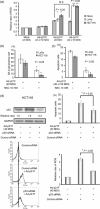Level of reactive oxygen species induced by p21Waf1/CIP1 is critical for the determination of cell fate
- PMID: 19432898
- PMCID: PMC11158913
- DOI: 10.1111/j.1349-7006.2009.01166.x
Level of reactive oxygen species induced by p21Waf1/CIP1 is critical for the determination of cell fate
Abstract
p21(WAF(1)/)(CIP(1)) is a well-known cell cycle regulatory protein which is overexpressed in several cancer cell lines, and known to determine cell fate. We generated three recombinant adenovirus vectors that expressed either the full-length p21 (Ad-p21F), a p21 mutant with a deletion of the C-terminal proliferative cell nuclear antigen (PCNA) binding domain (Ad-p21N), or a p21 mutant with a deletion of the N-terminal cyclin-dependent kinase binding domain (Ad-p21C). We transfected these vectors into five cancer cell lines. Premature senescence was induced in all of the lines only following transfection with Ad-p21N and Ad-p21F. In addition, apoptosis was also induced in LoVo and HCT116 cells that harbored wild-type p53 and the reactive oxygen species (ROS) level was higher than in senescent cells. Finally, the induction of apoptosis was inhibited by using siRNA to downregulate p53. This observation implies that there is a feedback signaling loop involving p21/ROS/p53 in apoptotic responses. It appears to be, at least in part, driven by high levels of p21 protein. Next, we investigated the cell death effect of endogenous p21 protein on cell fate using sodium butyrate (NaB). Treatment with 1 mM NaB or 2 to 5 mM NaB induced senescence or apoptosis, respectively. The level of intracellular ROS in 5 mM NaB treated cells was 2-fold higher, compared with that in 1 mM NaB treated cells. We also demonstrated that DNA damage response signals including ataxia telangiectasia mutated, gammaH2AX, and p38 MAPK were involved in NaB-induced cell death. The magnitude of intracellular ROS levels in response to p21 elicited either senescence or apoptosis in the cancer cell lines.
Figures







Similar articles
-
The p53-p21WAF1 checkpoint pathway plays a protective role in preventing DNA rereplication induced by abrogation of FOXF1 function.Cell Signal. 2012 Jan;24(1):316-24. doi: 10.1016/j.cellsig.2011.09.017. Epub 2011 Sep 22. Cell Signal. 2012. PMID: 21964066 Free PMC article.
-
The ATM/p53/p21 pathway influences cell fate decision between apoptosis and senescence in reoxygenated hematopoietic progenitor cells.J Biol Chem. 2005 May 20;280(20):19635-40. doi: 10.1074/jbc.M502262200. Epub 2005 Mar 7. J Biol Chem. 2005. PMID: 15753076
-
p38 Mitogen-activated protein kinase- and HuR-dependent stabilization of p21(Cip1) mRNA mediates the G(1)/S checkpoint.Mol Cell Biol. 2009 Aug;29(16):4341-51. doi: 10.1128/MCB.00210-09. Epub 2009 Jun 15. Mol Cell Biol. 2009. PMID: 19528229 Free PMC article.
-
Defenses against Pro-oxidant Forces - Maintenance of Cellular and Genomic Integrity and Longevity.Radiat Res. 2018 Oct;190(4):331-349. doi: 10.1667/RR15101.1. Epub 2018 Jul 24. Radiat Res. 2018. PMID: 30040046 Free PMC article. Review.
-
p21 in cancer: intricate networks and multiple activities.Nat Rev Cancer. 2009 Jun;9(6):400-14. doi: 10.1038/nrc2657. Nat Rev Cancer. 2009. PMID: 19440234 Free PMC article. Review.
Cited by
-
Romidepsin (FK228), a potent histone deacetylase inhibitor, induces apoptosis through the generation of hydrogen peroxide.Cancer Sci. 2010 Oct;101(10):2214-9. doi: 10.1111/j.1349-7006.2010.01645.x. Epub 2010 Jul 7. Cancer Sci. 2010. PMID: 20624163 Free PMC article.
-
Huperzine A attenuates nonalcoholic fatty liver disease by regulating hepatocyte senescence and apoptosis: an in vitro study.PeerJ. 2018 Jun 26;6:e5145. doi: 10.7717/peerj.5145. eCollection 2018. PeerJ. 2018. PMID: 29967757 Free PMC article.
-
Protective effect of myokine IL-15 against H2O2-mediated oxidative stress in skeletal muscle cells.Mol Biol Rep. 2014 Nov;41(11):7715-22. doi: 10.1007/s11033-014-3665-9. Epub 2014 Aug 8. Mol Biol Rep. 2014. PMID: 25103021
-
Camptothecin induces G2/M phase arrest through the ATM-Chk2-Cdc25C axis as a result of autophagy-induced cytoprotection: Implications of reactive oxygen species.Oncotarget. 2018 Apr 24;9(31):21744-21757. doi: 10.18632/oncotarget.24934. eCollection 2018 Apr 24. Oncotarget. 2018. PMID: 29774099 Free PMC article.
-
Foxp3 is a key downstream regulator of p53-mediated cellular senescence.Oncogene. 2017 Jan 12;36(2):219-230. doi: 10.1038/onc.2016.193. Epub 2016 May 30. Oncogene. 2017. PMID: 27238838
References
-
- Von Zglinicki T. Telomeres and replicative senescence: Is it only length that counts? Cancer Lett 2001; 168: 111–6. - PubMed
-
- Di Leonardo A, Linke SP, Clarkin K, Wahl GM. DNA damage triggers a prolonged p53‐dependent G1 arrest and long‐term induction of Cip1 in normal fibroblasts. Genes Dev 1994; 8: 2540–51. - PubMed
-
- Campisi J. Cellular senescence as a tumor‐suppressor mechanism. Trends Cell Biol 2001; 11: S27–S31. - PubMed
-
- Dotto G. p21 (WAF1/CIP1): more than a break to the cell cycle? Biochim Biophys Acta 2000; 1471: M43–M56. - PubMed
Publication types
MeSH terms
Substances
LinkOut - more resources
Full Text Sources
Other Literature Sources
Research Materials
Miscellaneous

